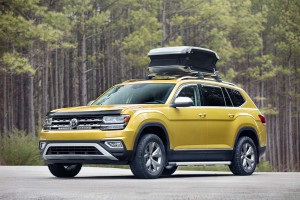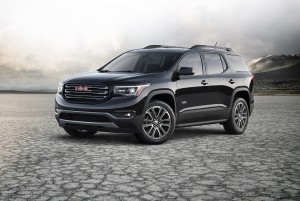
Ford Sales VP Mark LaNeve said the company's May sales were up on the strength of its SUVs and trucks.
Strong sales of crossover and sport utility vehicles and trucks, kept the industry anchored during May as overall sales stayed flat with General Motors, Fiat Chrysler Automobiles N.V. and Toyota posting small declines and Ford, Nissan and Volkswagen/Audi posting modest gains.
GM’s May total sales were 237,364 vehicles, which is down 1% from last year, largely due to a 36% drop in fleet sales. However, the company’s U.S. retail sales of 191,388 vehicles, up slightly from last year. GM’s May retail performance was driven by exceptionally strong crossover sales at Chevrolet, Buick, GMC and Cadillac.
“As we see the industry shift to more crossovers, we are extremely well positioned to take full advantage of this dynamic,” said Kurt McNeil, GM’s U.S. vice president of Sales Operations.
“We expect these launches will enable us to continue gaining retail share as we introduce more all-new compact and midsize crossovers than anyone else, including the all-new GMC Terrain, Chevrolet Traverse, Buick Enclave and the Regal TourX.”
(Crossover sales may be hitting their peak, analyst believes. Find out more, Click Here.)
FCA reported a 1% drop in sales during May, compared with the same month in 2016. However, its retails sale, which account for 79% of total sales, were up 1%. Fleet sales were down 7% year over year as FCA US continues its strategy of reducing sales to the daily rental segment.
But FCA also reported that Jeep sales in the U.S. dropped 15% in May as FCA continued to go through critical model changes that have reduced sales of the Jeep Compass and Jeep Cherokee by double-digit figures. So far this year, Jeep sales in the U.S have dropped by 13%, due in some measure to a 60% cut in fleet sales.
Ford Motor Co. said sales for May 2017 increased 2.2% compared with last year. Retail results declined 0.8%, while fleet sales increased 8.4% as the company began increasing deliveries to rental fleets, a decision that’s bound to put pressure on car maker’s stock in the wake of the dismissal of former CEO Mark Fields and runs in stark contrast to its other Big Three competitors.
Ford also reported its average transaction pricing increased $2,100 last month, outpacing an industry increase of roughly $500.
Toyota Motor North America reported its U.S. May 2017 dropped 0.5% from May 2016 on a volume basis. Toyota division posted May 2017 sales of 192,847 units, up 0.1% on a volume basis, while its luxury brand, Lexus, dropped 4.8%.
“Although down from last year, the auto industry is still enjoying a solid year in 2017, with light trucks continuing to shine,” said Jack Hollis, group vice president and general manager, Toyota division. “We continue to see the SUV segment leading the way, with a best-ever May for RAV4, Highlander, and overall light truck for the Toyota division, where inventory remains at healthy levels for our customers during the summer buying season.
(Click Here to see more about sliding new vehicle sales last month.)
“We are also thrilled at how well the market is accepting our newest model, the C-HR, with its first full month of sales in May, as our dealers have started to build some inventory. So far, we are seeing strong interest from a younger demographic for the C-HR, which is exciting,” Hollis added.

VW's U.S. sales got a boost from the new Atlas, which hit showrooms in mid-May, selling more than 1,600 units.
Nissan Group reported an increase of 3% over the prior year as overall sales of Nissan-brand crossovers, trucks and SUVs set a May record, up 22%. The Infiniti luxury brand also had a strong month as sales increased 15%.
Volkswagen reported sales increased 4.3% over May 2016 as the company continued to rebound from the diesel disaster. May 2017 also marks the start of sales for the all-new, Chattanooga, Tennesee-built Atlas. Deliveries of the vehicle, which began mid-month, totaled 1,610 units.
Audi of America reported a May sales increase of 2.5% vehicles, as the SUVs and the A4, A5 models led the gains. May 2017 marked the 77th consecutive month of record sales for Audi of America, as well as the fifth-best sales month in the brand’s U.S. history, the automaker reported.
The steady increase in the sales of crossovers and trucks also has helped raise transaction prices and pushed many new customers into leasing, which has created new challenges for dealers and manufacturers as the current cycle moves on.
Analysts at Kelley Blue Book reported the estimated average transaction price for light vehicles in the United States was $33,261 in May 2017 and new car have increased by $847 or 2.6% from May 2016, fell by $266 from April.
“Transaction prices continue to climb at a steady rate, driven by the weakening sales mix of cars which is estimated at 38% in May, down from 41% one year ago,” said Tim Fleming, analyst for Kelley Blue Book.
(To see how crossovers/utes could account for half the U.S. new vehicle market, Click Here.)
“Compact SUVs, the most popular segment in terms of sales, saw an increase of 2% year-over-year and clearly remain in very high demand. There are signs, however, of discounts in SUV segments that are growing quickly, including subcompact and luxury SUVs, which are likely helping to fuel those segments’ double-digit sales growth this year.”

